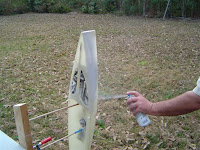 Here are some photos of the final paint job on the hull. When the weather presents a good day for outside spraying I will put some automotive clear coat on the hull to protect the paint. Being water based paint, it is pretty fragile at the moment. After the clear coat goes on I can then paint the cockpit and the deck. I still have much to do on the boat, but very happy to have some paint on her. I need to drill a hole for the rudder tube, drill a hole for the keel bolt as well as drilling holes for various fairleads and a deck block. I have to make my rigs and sails and then work on connecting the lead bulb to the keel. The keel and the rudder also need to be painted. WOW! I have a lot of work remaining on the boat, but so far it has been a very satisfying project. I need to thank Al, Hew and Dave for all of their help, advice, assistance so far in this project. THANKS GUYS!
Here are some photos of the final paint job on the hull. When the weather presents a good day for outside spraying I will put some automotive clear coat on the hull to protect the paint. Being water based paint, it is pretty fragile at the moment. After the clear coat goes on I can then paint the cockpit and the deck. I still have much to do on the boat, but very happy to have some paint on her. I need to drill a hole for the rudder tube, drill a hole for the keel bolt as well as drilling holes for various fairleads and a deck block. I have to make my rigs and sails and then work on connecting the lead bulb to the keel. The keel and the rudder also need to be painted. WOW! I have a lot of work remaining on the boat, but so far it has been a very satisfying project. I need to thank Al, Hew and Dave for all of their help, advice, assistance so far in this project. THANKS GUYS!Oh yeah, my choice of color? "Porn Star Pink" - the the link below to the website of auto air colors. These paints go on easy, but are water based so a clear is required to protect the paint job. If I had goofed, it would have been relatively easy to wash the old paint off and start over. This paint can not be sanded between coats or after a coat prior to clear coating.
















































